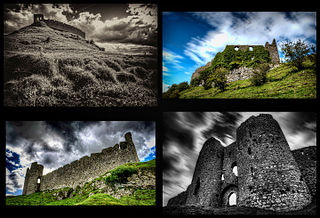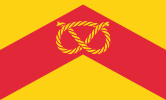
Uttoxeter is a market town and civil parish in East Staffordshire, England, near to the Derbyshire county border.

Elizabeth de Clare, 11th Lady of Clare was the heiress to the lordships of Clare, Suffolk, in England and Usk in Wales. She was the youngest of the three daughters of Gilbert de Clare, 6th Earl of Hertford and Joan of Acre, and sister of Gilbert de Clare, who later succeeded as the 7th Earl. She is often referred to as Elizabeth de Burgh, due to her first marriage to John de Burgh. Her two successive husbands were Theobald II de Verdun and Roger d'Amory.

Earl of Shrewsbury is a hereditary title of nobility created twice in the Peerage of England. The second earldom dates to 1442. The holder of the Earldom of Shrewsbury also holds the title of Earl of Waterford (1446) in the Peerage of Ireland and Earl Talbot (1784) in the Peerage of Great Britain. Shrewsbury and Waterford are the oldest earldoms in their peerages held by someone with no higher title, and as such the Earl of Shrewsbury is sometimes described as the premier earl of England and Ireland.

Aunay-sur-Odon is a former commune in the Calvados department in the Normandy region of north-western France. On 1 January 2017, it was merged into the new commune Les Monts d'Aunay.
Baron Wrottesley, of Wrottesley in the County of Stafford, is a title in the Peerage of the United Kingdom. It was created on 11 July 1838 for Sir John Wrottesley, 9th Baronet. He was a Major-General in the Army and also represented Lichfield, Staffordshire and Staffordshire South in House of Commons. The Wrottesley family's original patronymic was 'de Verdun', which meant that the creation of the title Baron Wrottesley represented the third barony created by a branch of the de Verdun family in England. The other two were established by Theobald de Verdun, 1st Baron Verdun of Alton Castle and Sir John de Verdon, 1st Baron Verdon, lord of Brixworth in Northamptonshire and Bressingham in Norfolk.

Edmund Mortimer, 2nd Baron Mortimer of Wigmore was the second son and eventual heir of Roger Mortimer, 1st Baron Mortimer of Wigmore. His mother was Maud de Braose.
Theobald le Botiller, also known as Theobald Butler, 2nd Baron Butler was the son of Theobald Walter, 1st Baron Butler and Maud le Vavasour. He had livery of his lands on 18 July 1222.

Cheadle is a market town and civil parish in the Staffordshire Moorlands District of Staffordshire, England, with a population of 12,000 at the 2021 census. It is located between Uttoxeter, Leek, Ashbourne and Stoke-on-Trent.

Bertram de Verdun was the name of several members of the Norman family of de Verdun, native to the Avranchin.

Alton Castle is a Gothic-revival castle, on a hill above the Churnet Valley, in the village of Alton, Staffordshire, England. The site has been fortified in wood since Saxon times, with a stone castle dating from the 12th century. The current castle was constructed in the mid-19th century by John Talbot, 16th Earl of Shrewsbury, of nearby Alton Towers. Since 1967 the castle has been designated a Grade I listed building. It is also a scheduled ancient monument.

Castle Roche is a Norman castle located some 10 km north-west of Dundalk, County Louth, Ireland. It was the seat of the de Verdun family, who built the castle in 1236 AD.

William Montagu, 2nd Baron Montagu, was an English peer, and an eminent soldier and courtier during the reigns of Edward I and Edward II. He played a significant role in the wars in Scotland and Wales, and was appointed steward of the household to Edward II. Perhaps as a result of the influence of his enemy, Thomas, 2nd Earl of Lancaster, Edward II sent him to Gascony as Seneschal in 1318. He died there in October of the following year.
Hulton Abbey is a scheduled monument in the United Kingdom, a former monastery located in what is now Abbey Hulton, a suburb of Stoke-on-Trent. A daughter house of the Cistercian Combermere Abbey, the abbey was founded by Henry de Audley in the early 13th century. Throughout its life, the abbey was relatively small and poor, with one of the lowest incomes of all Staffordshire religious houses. The abbey was dissolved by Henry VIII in 1538, with its land and assets being sold.
The Lordship of Meath was an extensive seigneurial liberty in medieval Ireland that was awarded to Hugh de Lacy by King Henry II of England by the service of fifty knights and with almost royal authority. The Lordship was roughly co-extensive with the medieval kingdom of Meath. At its greatest extent, it included all of the modern counties of Fingal, Meath, Westmeath as well as parts of counties Cavan, Kildare, Longford, Louth and Offaly. The Lordship or fiefdom was imbued with privileges enjoyed in no other Irish liberty, including the four royal pleas of arson, forestalling, rape, and treasure trove.

Alton Towers is located near the village of Alton in Staffordshire, England. The former country estate was a former seat of the Earls of Shrewsbury. It is now a major theme park in the United Kingdom. In 2012, it attracted 2.4 million visitors, making it the most visited theme park in the United Kingdom and 9th most visited theme park in Europe. It employs in excess of 2,000 staff members during the summer months.
Henry Audley was an English royalist baron. He was made Constable to Hugh de Lacy, 1st Earl of Ulster

The Uttoxeter Casket, also known as Philip Nelson's casket, is an Anglo Saxon reliquary from Uttoxeter, Staffordshire in the United Kingdom. As of 2017, it is held at the Cleveland Museum of Art in Ohio, United States. House-shaped and carved from a single piece of boxwood, it remains the only known surviving wood carving with such an elaborate iconographic programme from this period of British history.
Theobald de Verdun (1278–1316) was the second and eldest surviving son of Theobald de Verdun, 1st Baron Verdun, of Alton, Staffordshire, and his wife Margery de Bohun. The elder Theobald was the son of John de Verdon, otherwise Le Botiller, of Alton, Staffordshire, who was killed in Ireland in 1278. John, in turn, was the son of Theobald le Botiller and Roesia de Verdun. Roesia was the daughter of Nicholas de Verdun, who was the son of Bertram III de Verdun. When King Henry II of England invaded Ireland in 1171, this Bertram was appointed Seneschal for the undertaking, that is to say, he was responsible for provisions and stores. The Verdun family became major landowners in Ireland, especially in County Louth and County Meath.
William de Shepesheved was an English chronicler and Cistercian monk.














